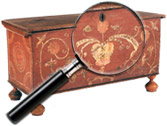|
|
Robert Atkinson Fox (1860-1935)
Born Robert Atkinson Fox on December 11, 1860 in Toronto, Canada, Fox studied in Canada and Europe prior to arriving in America. He eventually went on to become one of the early 20th century’s most popular, most diverse, and most reproduced artists of his time with his work appearing as art prints, calendars, advertising pieces, ink blotters, candy and handkerchief boxes, jewelry boxes, magazine covers, children’s books, newspaper inserts, postcards, [...] Click here to continue reading.
Apocryphal – Definition
Apocryphal, the adjective form, means “of doubtful authenticity,” according to Merriam-Webster’s online dictionary. Apocrypha, the noun form, means “writings or statements of dubious authenticity,” again according to Merriam-Webster.
Apocrypha is actually a Greek word that means something closer to “obscure” or “hidden away.” The original meaning of the word, the Apocrypha in the proper noun sense, refers to religious texts outside of the traditional or accepted religious canon. Through connection with [...] Click here to continue reading.
Jesse Woodson James, American Outlaw
Courtesy of James Julia Auction Company, presented in conjunction with the sale of Jesse James’ personal Colt revolver and holster rig (p4A item # D9737835)
Jesse Woodson James was born Sept. 5, 1847 in Clay County, Missouri. He had an older brother, Frank and a sister. His father, a minister, left soon after Jesse was born to go to California to “minister” to the 49er miners. He died in [...] Click here to continue reading.
Hoosier and the Hoosier Group
The word “Hoosier” is one of those words whose origins are lost to time. Even The Oxford English Dictionary offers no real guidance about where the word came from. What we do know is that “Hoosier” was first documented in the mid-1820s, and within a decade, it had entered general usage. John Finley, a Hoosier himself from Richmond, write a poem titled, “The Hoosier’s Nest” that was published in [...] Click here to continue reading.
Hires Root Beer
While traveling in 1875, Charles E. Hires, a Philadelphia pharmacist, first tasted root beer. Root beer, traditionally made with sassafras, was a popular “small beer” or low-alcoholic drink in the colonial era, and was becoming popular in an alcohol-free format. While root beer has a long history, it has a wide range of recipes that call for everything from birch bark to vanilla, molasses to juniper berries, so Hires set out [...] Click here to continue reading.
The Sarcophagus in Decorative Arts
Derived from the Greek sarx, meaning flesh, and phagein, meaning eat, a sarcophagus is, essentially, a container for a body, much like a coffin or casket. Historically, sarcophagi were typically made of stone (though sometimes of other materials, such as wood or metal), with a relief-carved or pediment top, and designed to be above ground, and have been used by many cultures since ancient times.
An ancient [...] Click here to continue reading.
Charles Marion Russell (1864-1926)
Charles Russell was as famous for his personal character as he was for his artistic career. A simple and modest man, he left the Midwest to pursue a life on the frontier. While residing primarily in Montana for the remainder of his life, Russell, or “Cowboy Charlie”, went on to become the state’s favorite son and achieve great renown for his depictions of the American West.
An [...] Click here to continue reading.
Ormolu
Ormolu, an 18th-century English term, is from the French phrase or moulu, with “or” indicating gold and “moulu” being a form of an old French verb moudre, which means “to grind up.” (This French term for this technique is bronze dore.) This idea of “ground-up gold”refers to the production process of ormolu, where high-quality gold is finely powdered and added to a mercury mixture and applied to a bronze object. Modern usage often [...] Click here to continue reading.
William Matthew Prior (1806 to 1873)
In the decades just before the advent of photography, a solid middle class began to form in America, a middle class that sought to aspire to and attempt to replicate some of the finer things of the upper class. Portraits were some of the most visible and sentimental of these objects, and as a result, portrait painters (or limners, as they were sometimes called) began to flock to [...] Click here to continue reading.
Panoramic Views
Accurately rendering a panoramic view has long challenged, obsessed and inspired artists. The trend seems to have sprung up in the 17th century, with works that served both as slightly more helpful, more detailed maps with various public or important buildings marked, but also as advertisements for towns and cities. Matthaeus Merian, a Swiss engraver who spent most of his career in Frankfurt, where he also ran a publishing house passed to [...] Click here to continue reading.
|
Recent Articles
- Charles Alfred Meurer – American Artist & Tromp L’Oeil Artist
- Sendak, Maurice – American Artist & Writer
- Godie, Lee – American Artist
- Davis, Vestie – American Artist
- Bartlett, Morton – American Artist
- Mackintosh, Dwight – American Artist
- Evans, Minnie Jones – African-American Artist
- Mumma, Ed (Mr. Eddy) – American Artist
- Nice, Don – American Artist
- Savitsky, John (Jack) – American Artist
- Gordon, Harold Theodore (Ted) – American Artist
- Dial, Thornton – African-American Artist
- Doyle Sam – American Artist
- Johnson, Lester Frederick – American Artist
- Finster, Howard – American Artist
|
|
